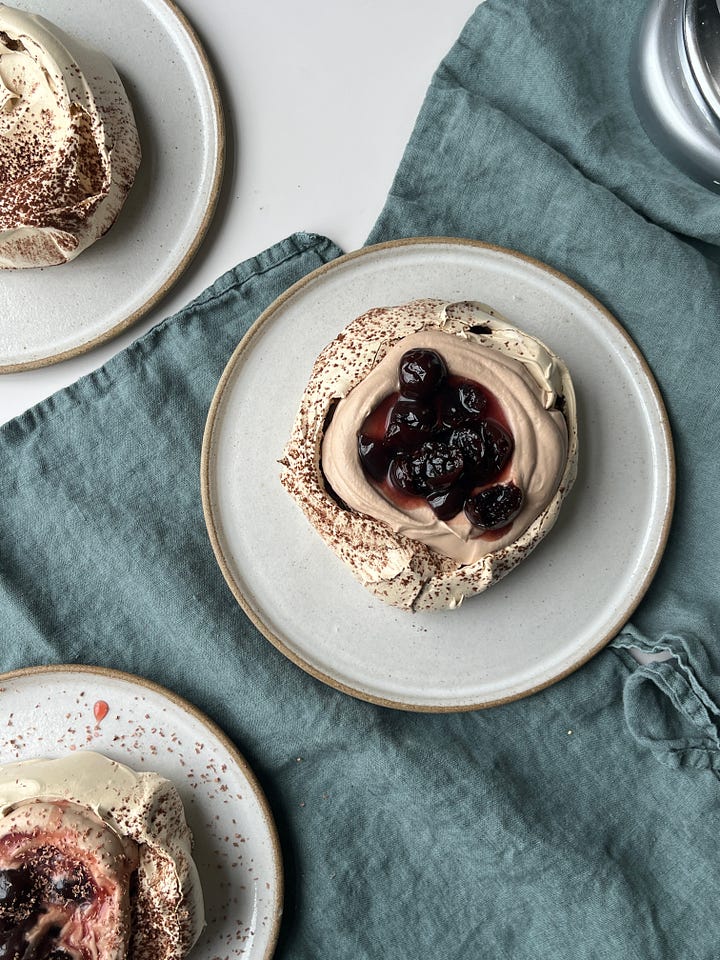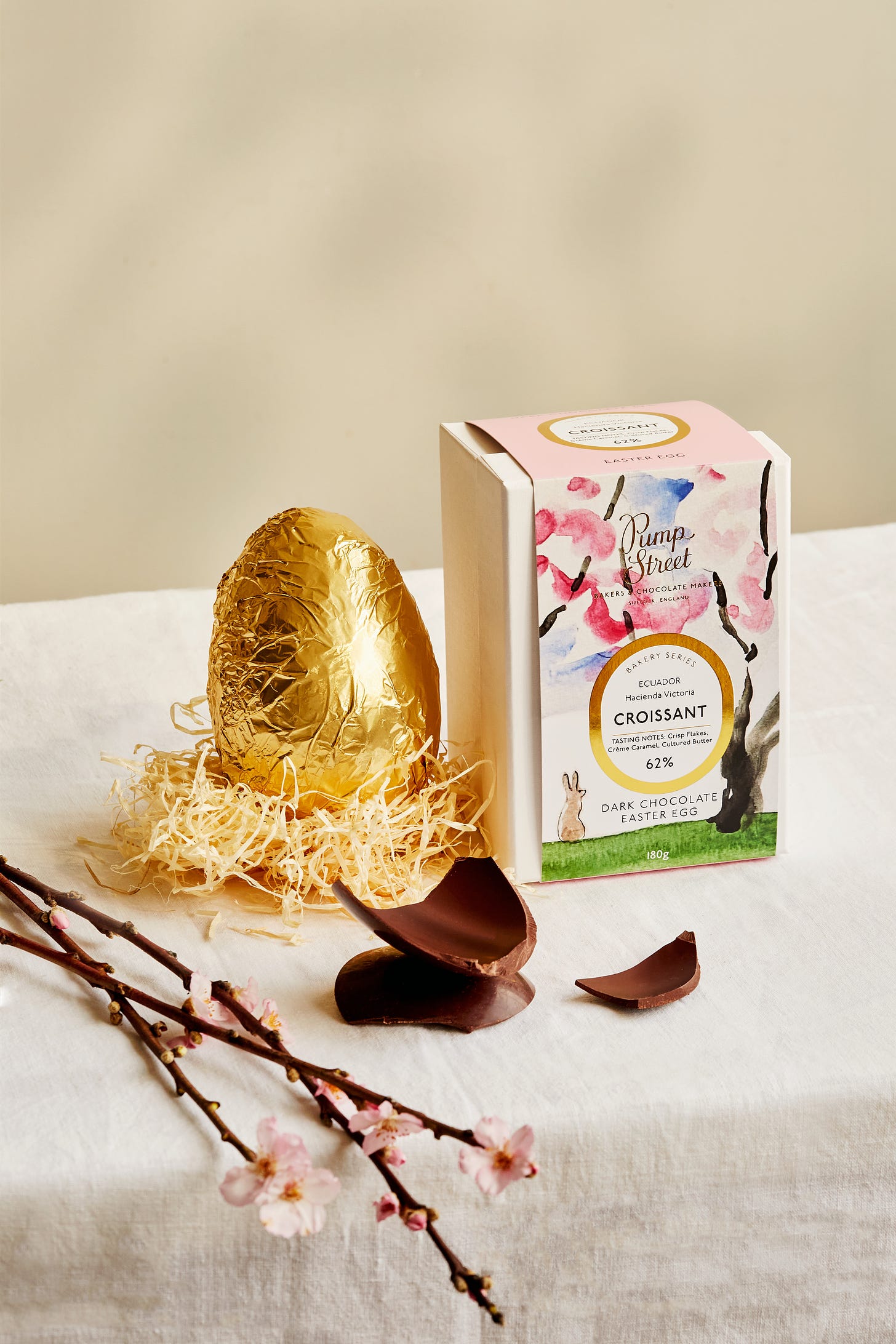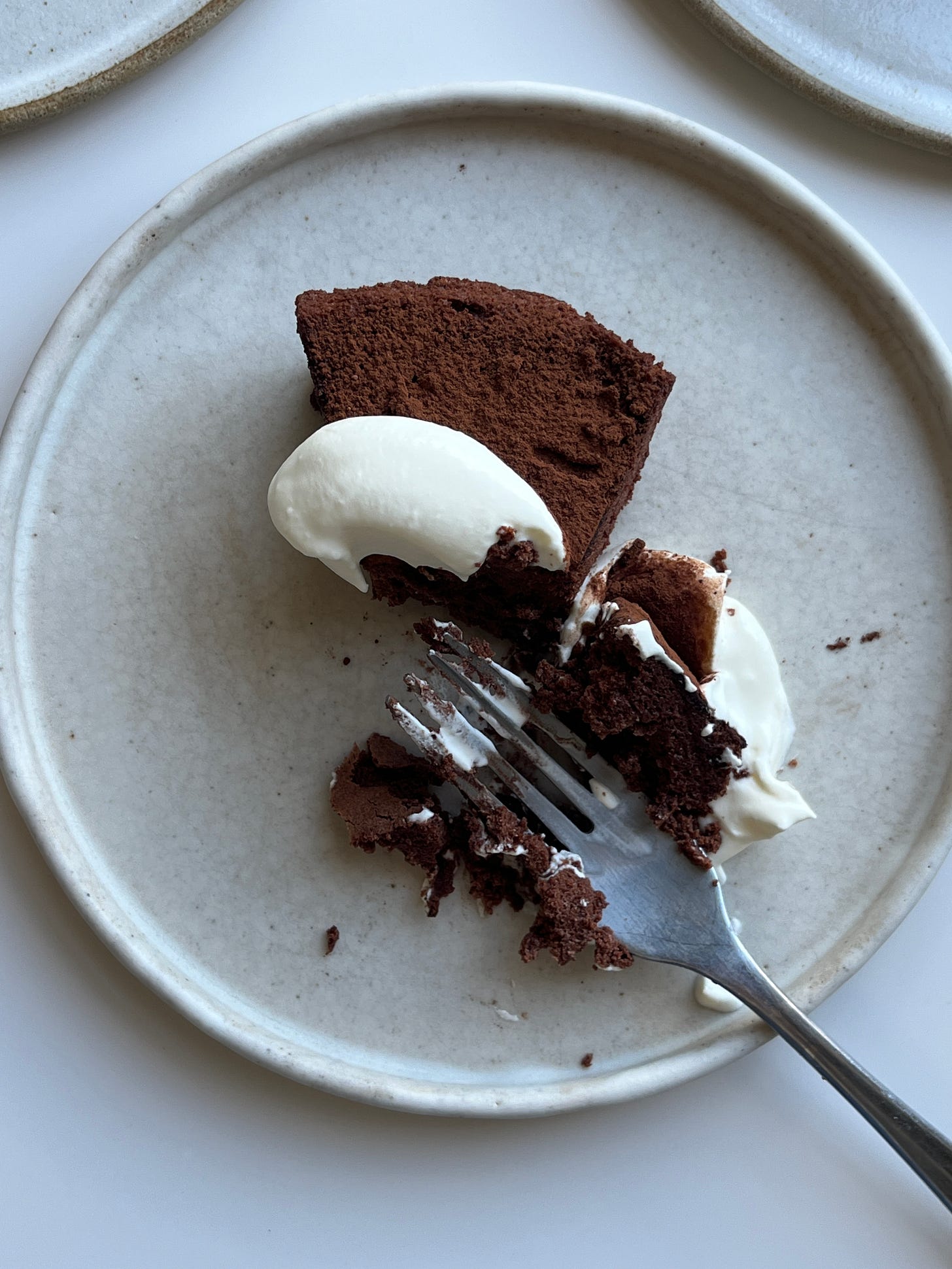Hello,
Welcome to today's edition of Kitchen Projects. Thank you so much for being here.
Today, we are getting into the subject of Flourless Chocolate Cake, perfect for Easter Sunday centrepieces and low effort / high reward dinner parties in your future; It’s light and moussey, filled with air and so light and rich at the same time. I think you’re going to love it.
Over on KP+, the chocolate theme continues with my new favourite dream dessert - Mocha Pavlovas with a Tangy Milk Chocolate Cream. Click here for the recipe! I'm also running a giveaway for a gorgeous Pump St. Croissant Chocolate (!) Easter Egg plus a 10% discount for KP+ only. How fun is that?
What's KP+? Well, it's the level-up version of this newsletter. By joining KP+, you will support the writing and research that goes into the newsletter (including the commissioning - and fair payment - of all the writers), join a growing community, access extra content (inc., the entire archive) and more. Subscribing is easy and only costs £6 per month or just £50 per year (equivalent to £4.10 per month). Why not give it a go? Come and join the gang!
Love,
Nicola
Pump St. x Kitchen Projects giveaway!
I’m very excited because I’ve teamed up with the wonderful, award-winning craft chocolate makers Pump St. Chocolate for today’s newsletter.
I used their beautiful 72% Solomon Island pastilles to test all the cakes in today’s newsletter and absolutely love all of their products. Excitingly, this year, Pump St is making their very first large egg made from Croissant 62% Dark Chocolate. It’s super limited edition, and they are kindly offering a 10% discount to my KP+ subscribers. Check the KP+ newsletter for the code.
As well as this, we’re doing a cute giveaway! To be in with the chance of winning one of these gorgeous Easter Eggs, delivered in time for the weekend, just sign up for their mailing list on the link below (scroll to the bottom and stick your email in) and we’ll pick a random winner tomorrow!
Always in search of chocolate
When I was younger, I sought out only the most chocolatey desserts. I'd house an entire Colin the caterpillar with a few friends in one sitting or easily disappear a few packets of choco Leibniz or mini rolls. The threshold I've since developed simply did not exist. In 2012, my mug cupboard was overrun with Cadbury mugs - mainly mini egg ones - that were, for no good reason, sold with chocolate eggs, which I'd buy at severely discounted prices in the weeks following Easter. There were at least twelve in my collection at one point. My obsession with chocolate was so extreme one Easter that I went off eating it all together for a time, my ceramics collection acting as a cautionary reminder of my previous excesses.
But don't worry. Over the last fourteen years, I've been back in business with Easter chocolate excess. Except these days, I'm not seeking the most outrageously fudgy recipe. Instead, I'm looking for the intersection between richness and lightness. This week, I'm thrilled to suggest a beautiful chocolate centrepiece for your Easter table: my ultimate flourless chocolate cake. It has such a light texture, like a barely set mousse:
Over on KP+, I have some extreme trials and tribulations ft. chocolate / adjacent flavoured meringues. I almost lost my mind, but I'm very happy with the final result, which includes the MOST gorgeous tangy whipped chocolate cream that I can (and definitely was) eat by the spoonful. You can use more sophisticated preserved cherries or give in to the mini eggs:


What even IS flourless chocolate cake?
Let it be known up front that flourless chocolate cakes are not all created equal.
It’s a stalwart of restaurant and bakery menus, but its form varies. From the ultra-rich chocolate nemesis at River Cafe, a black arrow of a slice, to the two-layered chocolate to the almond-laced Torta Caprese at your local Italian, it wildly varies from moussey to dense truffle textures (Felicity Cloake outlines many famous recipes in her 2014 article here). I suppose we need to get the big question out the way first - is this even a cake?! Well, at the very least, it's cake-shaped (usually), though it's much more like a rich dessert, a baked mousse of sorts.
Flourless chocolate cake is an intriguing subject because of its relatively bare ingredient list. There's nothing I love more than a recipe with simple ingredients crossed with more complex technique. How can we adjust and alter how they are balanced and introduced to achieve our ideal result?
Almost all recipes consist of just four ingredients: Chocolate, Butter, Sugar and Eggs. Some forgo the sugar altogether, while others might include cocoa powder. By combining these four ingredients, using a variety of techniques (more on that later), you achieve a range of results, some successful, some less so.
I compared some of the most popular recipes - the River Cafe (though their nemesis recipe has famously earned a bit of a reputation as being very difficult to recreate, giving a new meaning to its namesake) among them - and the ratio of chocolate ranged from 20% to 45%, the sugar 0% - 25%, the butter from 15%-30%. But what does it all mean? If you google 'flourless chocolate cake' the range of textures and sizes is extraordinary. So, where to begin?
The tests
A classic cake, a Victoria sponge, has a balanced number of tenderisers and tougheners. In flourless chocolate cake, the odds are already stacked against us to make a coherent cake - by removing one of the essential structure builders, the flour, the challenge is set.
To get back to basics, I made a batch of 'flourless chocolate cake' with equal parts sugar, butter, chocolate and eggs. I whisked the eggs until thick and floofy (more on techniques later), then folded in the melted butter and chocolate mix. I also tried out milk, dark and white chocolate to see how the cakes varied:
In the current ratios, the cake is a complete failure. It lacks structure and is overly sweet. The too-high proportion of sugar creates a thin, crisp crust (which is gorgeous) but a completely gooey centre. The cakes rose a lot in the oven and fell when cooling - this is because there were not enough tougheners, e.g. flour / eggs in comparison to the sugar/fat to create structure to capture all of the rise.
You can see how important the cocoa solids are for structure by comparing the cakes made with dark chocolate, milk and white chocolate:
So, let’s remind ourselves of WHAT is happening here.
Role of flour
Understanding the role of flour is, ironically, one of the most important things to consider when baking a flourless chocolate cake. Flour is considered a "toughener", providing structure through gluten and starch. Though gluten, the protein responsible for chewy baguettes and lofty loaves which form in the presence of water, often gets all the credit for being the scaffold of our bakes, we really owe a lot to starch gelatinisation. This is when flour absorbs water and swells, creating body and texture. When baked, the starch structure and proteins (gluten) are set in place.
Role of Eggs
Eggs are also considered 'tougheners' in baking. When heated, eggs transform from gloopy to firm in a process called coagulation. The hardening of both eggs and flour is irreversible and happens when our bakes go into the oven.
Role of Chocolate
So what about chocolate? I revert to the wondrous piece from Octavia Lamb (read it here). Octavia explains that "Chocolate as we know it today, and in its truest form, is a blend of cocoa mass, cocoa butter and sugar, and sometimes an emulsifier such as soy lecithin." Cocoa beans are processed into cocoa nibs, which are then separated into cocoa fat and pure cocoa mass. Octavia explains, "Cocoa Mass is principally what gives chocolate its flavour. Cocoa Butter adds smoothness, keeping our cacao mass and sugar happily bound together … Cocoa Solids are the total combination of cocoa mass and butter. This is what is being referenced when chocolate is given a percentage. For example, 75% dark chocolate means that per 100g of chocolate, 75g is made purely of cocoa beans, and the remaining 25g will be made of other ingredients, usually sugar."
Cocoa powder is cocoa mass once most of the fat (cocoa butter) is extracted, then ground to a very fine powder. Cocoa powder can gelatinise, like a starch, so adding it into our cakes provides more body and structure.
So, in relation to our cake, chocolate is contributing flavour, fat and sugar as well as solids. In a flourless cake, when solids are few and far between, every little bit counts. This is why flourless chocolate cakes tend to use higher %, darker chocolate and rarely use milk or white chocolate.
Role of Sugar and Fat
Sugar and fat are both tenderisers, somewhat returning to their original state after baking. This is why high-sugar bakes, like cookies, pasteis de nata and brownies, can stay gooey long after cooling. This is also why baked goods made with liquid fats, like oils, appear softer and more tender - the fluidity of the fat makes a difference. Though butter is our chart-topper when it comes to flavour, its firm texture, once cooled, does not always win points in the texture department.
Beyond these inherent states, both sugar and fat have other roles in keeping things soft - sugar is highly hygroscopic, which means it attracts water. By attracting and holding the water, it can help limit gluten development as well as essentially retaining moisture. Something similar happens with fat - we can strategically force fat and flour to interact, the fat coating the flour and preventing gluten from forming. Acting as a physical blockade, the fat 'shortens' the gluten chains (and that, my friends, is why fat is sometimes called shortening.)
Finding the perfect ratio
So, how to adjust it for today's tests? To compensate for the complete lack of structure, the ratio of eggs and chocolate needs to dominate. Even though chocolate provides fat and sugar, it also has crucial cocoa mass. The sugar, as a result, can take a hit, along with the butter. As the base recipe for today's tests, I went for approximately 30% chocolate, 30% eggs, 20% butter and 15% sugar.
From here, I started adjusting the technique, cooking method and ratios as follows:
Eggs: I compared whisking whole eggs to a thick sabayon vs. separating the eggs and making versions with folded-in meringue as well as 'pate a bombe' base (basically an Italian/swiss heated meringue, but made with egg yolks instead of whites). I also tried variations with
Sugar: I tested versions with no added sugar
Cocoa powder: I tried varying quantities of cocoa powder for structure and flavour
Waterbaths: I split each recipe into two, baking one in a water bath to evaluate the impact on texture
The results
The 12 cakes I tested ranged from dense, rich and fudgy to light and airy. Even if a cake LOOKED light and smooth, the mouthfeel was often different. As you can see, plain baked pate a bombe (aka a meringue made with egg yolks) is a disaster. Unlike it's white counterpart, which bake to a crisp, it lacks structure.
There were two clear front runners - an ultra-soft cake made with whipped egg yolks, cocoa powder and butter (no chocolate, god forbid!!!) and an outrageously just-set mousse-like smooth version made with double egg whites. Out of all the recipes, these were the only two that were eaten in one go.
While I have room in my heart for dense flourless chocolate cake, there are a lot of perfect, rich recipes already out there. So, I've decided to pursue and share the version with whipped egg whites, with a little cocoa added (optionally) for stability. The super soft cake version is perfect, but the yield is SO bad (one really thin 8inch cake from almost six egg yolks…) that I can’t in my right mind pursue it.
Waterbath cooking, though faffy, makes a world of difference. Cooking a good flourless chocolate cake, or at least one with sensitive ratios, is not unlike cooking a custard - we are essentially just trying to very gently set a mousse and hold those bubbles in place! With eggs always at risk of over-coagulation and going tough, a water bath really helps to keep things ultra smooth. That being said, it is still possible to make a good (though denser) cake without one. As you can see here, the versions cooked in a waterbath have not cracked and have retained their shape much better.
Eating at room temperature
Two of the elements in this cake - butter and chocolate - harden in cooler temperatures, so eating this cake at room temperature is essential. You can either bake in advance and never refrigerate (though it can be harder to serve and remove the base paper) or bake in advance, chill in the fridge, flip into your plate and then bring back to room temp before eating. I was in a rush to get my cake back to all its soft glory when taking photos a few days ago, and I put it in the microwave for 30 seconds - 1 minute. It was perfect. No shame, there! I even microwaved a slice until wobbling and warm - it was divine.
Why don't we just make brownies?
As I made my 12th recipe of flourless chocolate cake, I did wonder what I was hoping to achieve here, dietary requirements aside?
So, here’s a small note on the other great rich chocolate dessert. My ideal brownies have a richer texture - almost like biting into a dense chocolate-laced butter cloud. They don't have a dissolving texture and use a proportion of flour to provide crucial stability and structure. Because of the additional flour and structure, brownies have a higher ratio of sugar and might use milk chocolate rather than dark. By all means, if you are after a great brownie recipe, I GOT YOU:
Ok, let’s make cake.
Recipe: Flourless Chocolate Cake
Equipment: 1 x 8inch tin. A 9inch tin would also work, just watch the bake!
Serves 8
170g Dark Chocolate
110g Butter
¼ tsp Flaky Salt
10g Cocoa powder (optional)
35g Egg Yolks (about two)
180g Egg Whites (about five or six)
140g Caster sugar
To serve
100g creme fraiche
100g double cream
Method
Preheat oven to 120c fan. Line an 8-inch tin with paper and wrap well with clingfilm and foil.
Start by melting the chocolate and butter together gently. Once melted, whisk in 2 tbsp of water, the salt and the cocoa powder. The water helps prevent the mixture from seizing when you later add the egg yolks.
Make the meringue: Add the egg whites into a bowl, then whisk on high speed for 30 seconds. For the next 30 seconds, add the sugar bit by bit. Turn the mixer to medium and whisk for 6-8 minutes until a glossy, dense meringue forms. It should be shiny and thick but not too stiff - when the beaters are lifted, it should gently flop onto itself. All our mixers are different, so keep checking - you want the meringue to be flexible and firm! You can finish it off by hand, if you want.
Whisk the egg yolks into the chocolate butter mixture. Then, whisk in about 40g of meringue to loosen the mixture. Gently fold the rest of the meringue mixture and chocolate mixture together.
Transfer into your lined pan and smooth with an offset spatula. Place tin into a deep sided, oven safe dish and carefully pour boiling hot water into the dish.
Bake for 45min-1 hour until risen and dry on top. If desired, you can temp the cake to ascertain doneness. It should be around 78-84c inside. If it cracks, don't worry! The top will become the bottom.
Remove from the oven and leave to cool completely - you can remove from the water once you are able to handle the tin. If a little water has gotten into your cake, don't worry too much - just drain as much as you can and leave. Sogginess actually isn't a concern with this cak!
To transfer the cake neatly, either chill completely in the fridge OR place in the freezer for 20 minutes then remove the tin and paper. Place the serving plate on top of the cake, then flip it, so the bottom is now the top. Dust with cocoa powder and enjoy at room temperature. Remember, you can microwave this cake (from fridge cold) for 30 seconds (then 10 second increments) to get it back to its best. To be honest, a slice warmed in the microwave for 20 seconds is pretty incredible!
Serve with whipped creme fraiche - combine equal parts creme fraiche and double cream and whip til thick and soft peaks. Spoon over slices cut with a hot, dry knife. The best way to achieve this is pouring water from a freshly boiled kettle over the knife then drying between slices.



















Hello! I baked and gave this cake to celebrate a mom who just had her third baby. I added a blood orange compote and Greek yoghurt whip.
The crumbs left on the parchment was so delicious and a melting texture— very excited to bake it again!!
you don't actually say that your cake pan is two pieces, but it must be if you're wrapping it in foil before putting it in a water bath. Is there some reason why we can't use a one piece pan and then not have to worry about wrapping it? Thank you